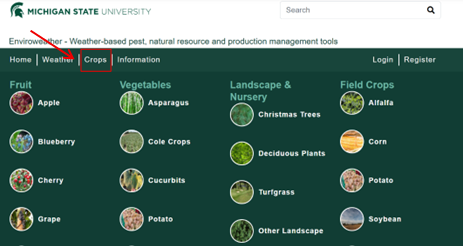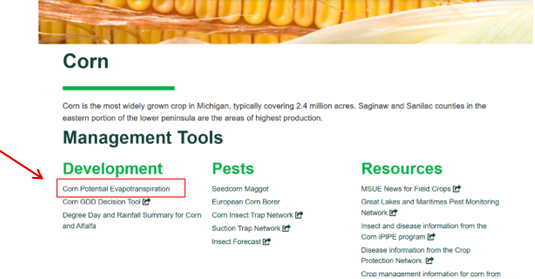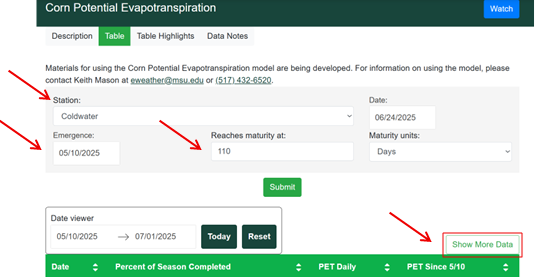Applying water at the right time and in the right amount
Strategic irrigation scheduling ensures water application matches the crop water needs while maximizing crop water productivity.

Timing and application rate are critical when it comes to irrigation. Applying water too early, too late, too little or in excess can lead to wasted water, reduced crop performance, and increased plant stress. As weather patterns become more unpredictable and water becomes an increasingly valuable resource, adopting strategies to apply water at the right time and in the right amount, known as irrigation scheduling, is essential for crop and water productivity.
There are several tools available to help with irrigation scheduling, but first it’s important to understand the basics. The primary role of irrigation scheduling is to apply water in a way that meets the crop’s water demand, also known as evapotranspiration (ET). The goal is to maintain adequate soil moisture within the root zone, ensuring water is readily available to the plants when they need it most.
Soil serves as a reservoir for water, and its capacity to store water varies depending on soil texture. Sandy soils drain faster and hold less water while clay soils retain more. After rainfall or irrigation, water drains through the soil, and what remains is called field capacity, the maximum water available to plants. If the soil dries out too much, it reaches the permanent wilting point, when plants can no longer access water and may begin to die. When soil pores are completely filled with water, saturation occurs, often resulting in runoff or deep percolation; water draining below the root zone and becoming unavailable to plants.
The difference between field capacity and the permanent wilting point is known as available water, the moisture that is accessible to plants. The maximum allowable depletion represents the percentage of available water that can be depleted before plants begin to experience water stress. This threshold varies depending on the crop type and growth stage. A common guideline is to irrigate before 40-50% of available water is depleted, as going beyond this point can negatively impact crop yield due to stress.
Table 1 provides typical available soil water content by soil texture for Michigan conditions. To estimate your field’s available water holding capacity, multiply the value (as a percentage) by the rooting depth of your crop. For example, sandy loam soil holds about 9.8% available water. If corn roots reach 3 feet deep, the root zone would contain approximately 3.5 inches of available water (0.098 × 36 inches). To avoid stress, it’s recommended to maintain 50% of the total available water, meaning irrigation should be scheduled before depletion exceeds 1.75 inches.
Table 1. Soil water content and recommended irrigation trigger points in Michigan (source: Michigan State University Extension bulletin E3445, “Improving Irrigation Water Use Efficiency: Using Soil Moisture Sensors”).
|
Soil texture |
Field Capacity (%) |
Permanent Wilting Point (%) |
Available Water (%) |
Trigger Point Range (%) |
|---|---|---|---|---|
|
Sand |
9.4 |
5 |
4.4 |
6.8 – 8.1 |
|
Loamy Sand |
12 |
5.7 |
6.3 |
6.2 – 10.1 |
|
Sandy Loam |
17.9 |
8.1 |
9.8 |
12.0 – 15.0 |
|
Loam |
31 |
14 |
17 |
20.8 – 25.9 |
A common and practical way to schedule irrigation is by using the checkbook method. Think of it like managing a bank account: rainfall and irrigation are deposits, and crop water use is a withdrawal. By tracking these inputs and outputs, you create a running balance of how much water is available in the soil’s root zone. When the soil water depletion reaches or exceeds the maximum allowable depletion, it’s time to irrigate. The goal is to refill the soil back to field capacity, while still leaving room for potential rainfall to avoid overwatering.
Another important consideration is staying ahead of irrigation needs. For example, center pivots typically take three to four days to cover an entire field, so it’s beneficial to begin irrigating before reaching the 50% maximum allowable depletion or to account for forecasted evapotranspiration when scheduling irrigation.
Michigan State University Extension offers helpful tools to support the checkbook method, including a soil water balance sheet and an Excel-based irrigation scheduler. More recently, Michigan State University (MSU) developed a mobile irrigation scheduling app that is user-friendly and accessible for growers on the go. It’s important to create a separate scheduling sheet or profile for each field, as crop type, soil texture, irrigation system capacity and rainfall can vary significantly from one location to another.
All of these tools rely on daily potential evapotranspiration (ETr) data and forecasted crop water demand for the upcoming week, available from 94 MSU Enviroweather stations across Michigan. By selecting the weather station closest to your field, you can access accurate estimates to help schedule your irrigation.
Another simple approach when using Enviroweather is to calculate crop water use by multiplying the reference evapotranspiration by a crop coefficient (Kc). The crop coefficient adjusts for differences in crop type and growth stage, allowing you to estimate how much water your specific crop needs. To use:
- Visit the Enviroweather website.
- Select “Crops” from the main menu.
- Click on your crop of interest (e.g., Corn).
- Choose “Corn Potential Evapotranspiration.”
- Select your nearest weather station and enter your crop’s emergence date.
- Click “Submit” to generate crop water use estimates.
- To view additional data such as temperature, rainfall or ETr, click “Show more data.”



Additionally, MSU Extension provides weekly crop water use estimates for three key regions in Michigan. To access these updates, visit Crop Water Use.
There are other methods available to schedule irrigation. For example, soil moisture sensors can provide real-time insights into field conditions. Refer to the “Utilizing Soil Moisture Sensors for Efficient Irrigation Management” fact sheet to learn more about how these sensors work and how to use them effectively.
For additional information and resources on irrigation management, please visit MSU Extension Irrigation.



 Print
Print Email
Email